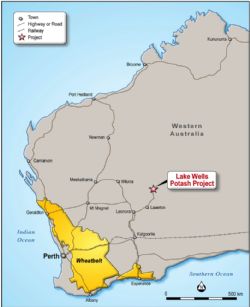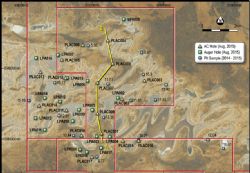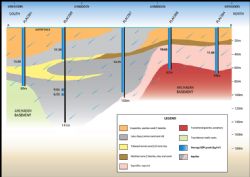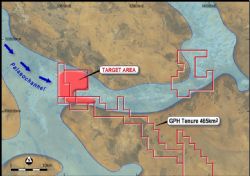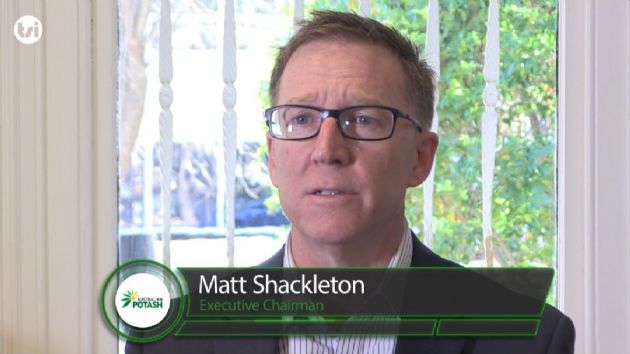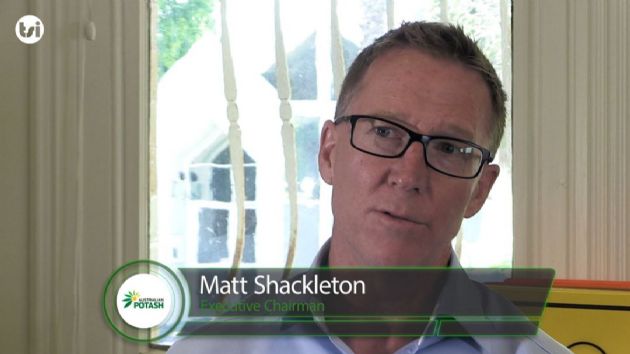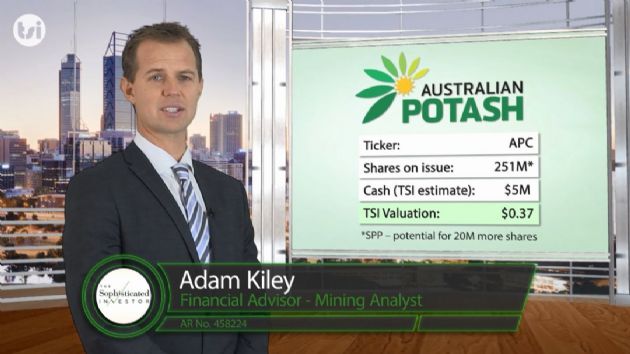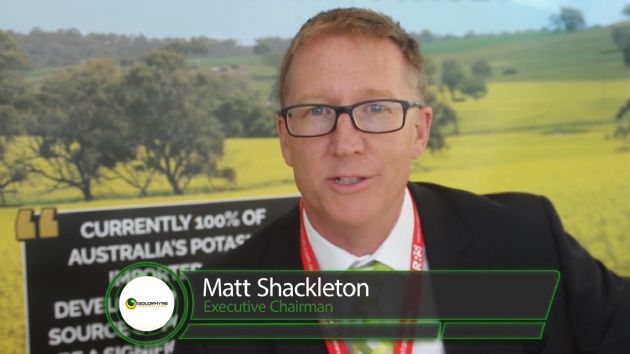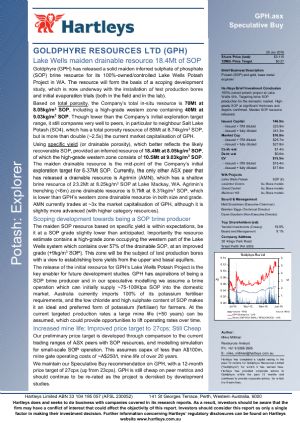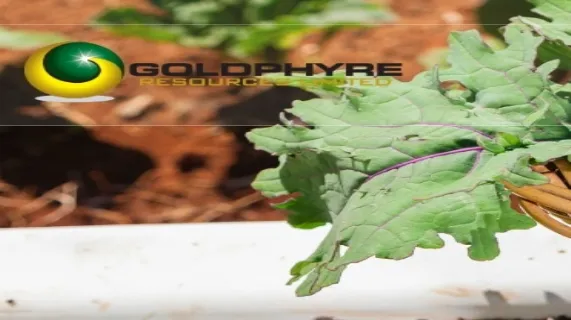
Outstanding High-Grade Sulphate of Potash Results to Depths of Over 100m
Perth, Aug 27, 2015 AEST (ABN Newswire) - Potash explorer Goldphyre Resources Ltd ( ASX:GPH) (Goldphyre) is pleased to advise results from the recently completed drilling program at its 100% owned Lake Wells Potash Project (Table 1 in link below). The program consisted of 1,227 metres of air-core drilling across 17 holes, and 18 shallow auger holes (Figure 2, Appendix 1 in link below). Drilling achieved depths up to 141 metres with holes planned to evaluate the downhole potassium sulphate (SOP) concentration throughout the aquifer and test SOP potential beneath land adjacent to the salt lake surface.
ASX:GPH) (Goldphyre) is pleased to advise results from the recently completed drilling program at its 100% owned Lake Wells Potash Project (Table 1 in link below). The program consisted of 1,227 metres of air-core drilling across 17 holes, and 18 shallow auger holes (Figure 2, Appendix 1 in link below). Drilling achieved depths up to 141 metres with holes planned to evaluate the downhole potassium sulphate (SOP) concentration throughout the aquifer and test SOP potential beneath land adjacent to the salt lake surface.
HIGHLIGHTS
Lake Wells Potash Project
- All 17 air-core (AC) holes and 18 auger holes returned very strong potassium (K) and potash (Sulphate of Potash or SOP) concentrations in brine across significant thicknesses and to significant depths
- Additionally, very high grades recorded not just from drill holes on the lake surface but also from surrounding lake margins
- Significant depth extensions to near-surface pit sample concentration in brine has been demonstrated, with best results from AC drill holes (1km - 2km spacing):
o PLAC001 including 89m averaging (5.48 kg/m3 K) 12.28 kg/m3 SOP
o PLAC002 including 54m averaging (5.04 kg/m3 K) 11.30 kg/m3 SOP
o PLAC004 including 69m averaging (5.18 kg/m3 K) 11.80 kg/m3 SOP
o PLAC007 including 96m averaging (5.68 kg/m3 K) 12.73 kg/m3 SOP
o PLAC008 including 62m averaging (4.74 kg/m3 K) 10.62 kg/m3 SOP
o PLAC014 including 63m averaging (5.46 kg/m3 K) 12.23 kg/m3 SOP
o PLAC015 including 102m averaging (5.19 kg/m3 K) 11.63 kg/m3 SOP
- In addition to the high-grade potash returned from the AC drill holes, concentration in brine averaging (5.43 kg/m3 K) 12.16 kg/m3 SOP was returned from across all auger holes
- Bedrock intercepted in 12 holes, with 3 holes completed at depths of over 135 metres
- Forward Steps - core-drilling program, installation of meteorological station, hydrogeological resource modelling
Executive Chairman of Goldphyre Matt Shackleton, said, "The very strong potassium grades recorded in over 260 samples from depths up to 141 metres downhole comprehensively validates our drill program plan. From surface we see significant high-grade, broad intercepts both on the lake surface proper, and from beneath the kopai dunes and lake surrounds. This has a very material impact on planning our forward work programs, as lake surface does not seem to dictate concentrations in brine, and access does not appear to present a problem. The Company is well funded for the next stage of work, and we are now engaging consultants across hydrogeological disciplines to fast track resource modelling.
The Project's location and access to infrastructure, and these outstanding results, make us confident that our forward work programs will further strengthen the case towards developing a project that can address the SOP needs of Australian farmers. Our goal is to target a low capital operation that initially supplies farmers and other potash users in Australia with a product that they currently import 100% of from costly overseas suppliers."
Technical Discussion
This air-core and auger drilling program is the Company's first focussed drill program testing the brine potash potential at The Lake Wells Project. The drill pattern is considered to be relatively close-spaced or 'tight' for a first pass brine-drilling campaign (Figure 2). The program was designed to test the presence and consistency of high-grade potash in brine:
1) At significant depths in the deep regolith recognised at Lake Wells from previous explorer's work and recent Goldphyre (non-potash) drill coverage; and,
2) Beneath transported sand and dune areas adjacent to the salt lake margins.
The program achieved the following:
1) It confirmed near-surface brine pit sampling results continue to depth, with broad downhole intercepts of high-grade potash to +130 metres (Figure 3 in link below);
2) It confirmed strong, high-grade potash grades from AC drill holes on sites adjacent to the lake surface. Over 50% of the drill holes were completed over a 50m - 400m range from the salt lake surface;
3) It generated very encouraging indicative brine flow test data from low pressure airlifting, ranging up to 2 litres per second, from drill holes both on the lake surface and adjacent surrounds;
4) It has given a more thorough understanding of regolith, palaeochannel form and the weathered Archaean bedrock profile; and,
5) It has provided a sound foundation of drill, sample and analytical data to commence JORC2012 compliant inferred resource modelling work.
Lithology types logged included surficial or near surface evaporite and sand/silt, silcrete+/-laterite, common lake clays with some well sorted sand units, puggy lacustrine clays with minor sand/silt and Archaean basement rocks including transitional porphyry, granite, ultramafic and amphibolite types. It is encouraging to note significant potash brine grades were also encountered in the weathered basement at and near the bottom of some holes.
Isolated lower value potassium in brine concentrations were returned from a small number of samples from some intervals in some of the AC drill holes (approximately 2.5% of all samples). A number of factors may have contributed to this decrease in concentrations, warranting further investigation, which is currently being conducted.
Goldphyre's Technical Director Brenton Siggs commented, "Our first potash drill program has really delivered, giving us valuable geology data and returning strong results that confirm very high potash concentrations both at depth and, very importantly, also off the lake surface. We are now in a position to focus on potash resource modelling and hydrogeology work."
At the time of logging, representative chip tray samples were collected and magnetic susceptibility readings taken. Results from a batch of selective mineral composite samples are pending.
FORWARD WORK PROGRAM
The Company has received proposals from hydrochemical, hydrogeological and hydrological consultants. With the selection of these technical experts Goldphyre will be in a position to begin work on modelling a resource at The Lake Wells Potash Project.
The discovery of potash concentrations in brine at significant depths and over significant widths, both on and off the lake surface, indicates clearly that this nascent potash project continues to grow. The Company is now planning field work programs, including further drilling, towards recovering core samples and other data that will feed into the measurement of a potash resource at the project.
ABOUT THE LAKE WELLS POTASH PROJECT
Logistics
Located approximately 300 kilometres from the north-eastern Goldfields rail head at Laverton, Western Australia, Goldphyre Resources' Lake Wells Potash Project is ideally positioned close to logistics and bulk distribution solutions.
Targetting the domestic market for potash demand from Australian farmers, the Project's SOP product can potentially be distributed through Kalgoorlie to the Western Australian wheatbelt, and via rail to the markets in South Australia and the eastern states.
Geological Setting
The Lake Wells Project is located on the north-eastern margin of the Yilgarn Craton, Western Australia. Geoscience Australia (Mernagh et al, 2013. Record 2013/039) recognised Lake Wells as a high potential potash salt lake system with interpreted palaeovalley trends (Figure 5 in link below).
Historic and recent Goldphyre drilling has revealed a variable regolith horizon consisting of surficial or near surface evaporite and sand/silt, silcrete+-laterite, common lake clays with some well sorted sand units and puggy lacustrine clays with minor sand/silt. Archaean basement rocks including transitional porphyry, granite, ultramafic and amphibolite types were logged at the end of some holes.
Goldphyre recently modeled previous explorers Western Mining Corporation's (WMC) drilling datai which indicated the volumetric estimate for the aquifer at the project at over 1.6 billion cubic metres (Table 2: Lake Wells Potash Project, Aquifer modelling and Figure 6: Lake Wells Potash Project, Aquifer model), and indicating favourable regolith profiles for brine extraction.
The Company emphasizes that modelling of historic drilling is of a preliminary nature only, but this data may now be incorporated in future resource modelling studies when combined with the recent air-core drilling results.
Planned drilling and new modelling work will further test the brine potash concentration along with aquifer properties, including but not limited to, sediment type(s), porosity and permeability throughout the target aquifer interval (near surface water table level to basement rock).
Potassium, Potash and Sulphate of Potash - SOP
SOP is prized as the premium source of potassium for fertiliser use, with its high potassium, accompanying sulphur and low chlorine content (typically 45% K, 18% S and < 1% Cl respectively).
Brine SOP deposits are relatively uncommon, with only 3 producing operations globally. Subject to location and access to infrastructure however, brine SOP projects typically occupy the lower end of the production cost curve. Currently there is not a brine SOP operation in Australia.
Potash brine exploration in Australia is growing strongly. The relatively slow development progress of high CAPEX potash projects, and global macroeconomic circumstances more generally, provide strong incentives for the development of domestic potash supplies.
To view all tables and figures, please visit:
http://www.abnnewswire.net/press/en/80799/potash
About Australian Potash Ltd
Australian Potash Limited (ASX:APC) is an ASX-listed Sulphate of Potash (SOP) developer. The Company holds a 100% interest in the Lake Wells Potash Project located approximately 500kms northeast of Kalgoorlie, in Western Australia's Eastern Goldfields.
Following the release of a Scoping Study in 2017, APC has been conducting a Definitive Feasibility Study (DFS) into the development of the Lake Wells Potash Project. The Company is aiming to release the findings of the DFS in H2 2019.
The Lake Wells Potash Project is a palaeochannel brine hosted sulphate of potash project. Palaeochannel bore fields supply large volumes of brine to many existing mining operations throughout Western Australia, and this technique is a well understood and proven method for extracting brine. APC will use this technically low-risk and commonly used brine extraction model to further develop a bore-field into the palaeochannel hosting the Lake Wells SOP resource.
A Scoping Study on the Lake Wells Potash Project was completed and released on 23 March 2017. The Scoping Study exceeded expectations and confirmed that the Project's economic and technical aspects are all exceptionally strong, and highlights APC's potential to become a significant long-life, low capital and high margin sulphate of potash (SOP) producer.
| ||
|




